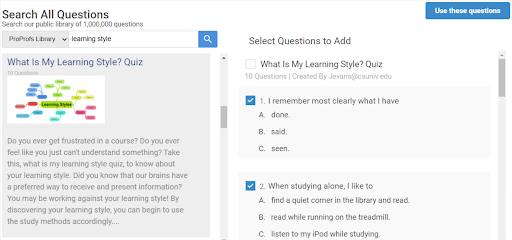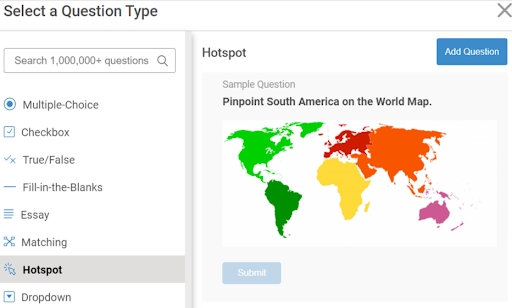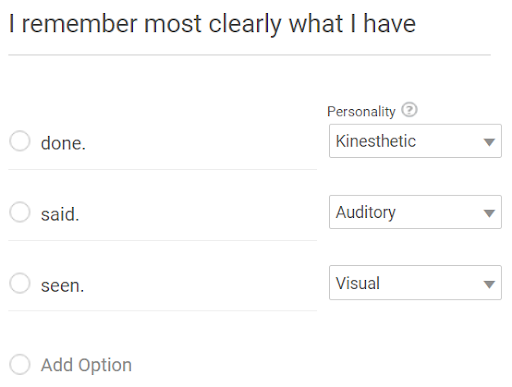
As a kid, I had a hard time keeping up with my Maths lessons, often finding myself stuck on one for days. And while I hoped this learning challenge would end sometime in my formative years, it continued well into my professional life.
But I’m not a slow learner; I just have a different learning approach.
It took me years to realize this simple fact and find out what learning method works best for me.
But this doesn’t have to be the case for every learner.
Whether you’re a teacher or trainer, you can use learning style quizzes to identify and implement the best learning techniques for your learners.
We all adapt to a particular method to learn something the best way we can. Some of us read, some watch videos, some listen to audiobooks, etc. The differences in how we understand or comprehend a given piece of information are nothing but a reflection of different learning styles that suit us.
In this article, we will look at how an online learning style quiz helps gauge someone’s learning style, identify knowledge gaps, and give results in the form of grades, deeper understanding, and a more fulfilling educational experience.
What Is a Learning Style Quiz?
A learning style quiz is a type of quiz that you deploy to identify a learner’s learning style & preferences. It helps learners better understand how they retain new information and provides the teachers/instructors an in-depth insight into learning abilities.
But before we talk in detail about learning style quizzes, let’s throw some light on learning styles.
What Is a Learning Style?
A learning style is a set of factors, behaviors, and attitudes that facilitate learning for an individual in a given situation. In other words, learning styles are different learning methods classified based on their compatibility with individual learners.
For example, the VARK learning style quiz classifies learning methods into Visual, Aural, Read/write and Kinesthetic. Learners with an auditory learning style learn best by listening to information. In contrast, visual learners can comprehend and digest new information quickly when it is presented in the form of charts, graphs, and images.
Let’s learn about the various learning styles an individual can have in the next section.
What Are the Different Types of Learning Styles?

Source: Turningpointcentre
Learning styles differ based on delivery method and can suit individuals and groups accordingly. Some learners use a mix of learning styles, while others stick to a single one.
Here are the most popular ones:
1. Visual
In the visual learning style, learners learn by observing things. They respond to colors, images, diagrams, and fonts. Instructors can use slide presentations, videos, or image-based questions to address this learning style. Visual learners learn by visualizing the information presented to them.
2. Auditory
In the auditory learning style, learners learn with the help of sound and music. Auditory learners typically have a good understanding of rhythm. Sound and music are great stimulators in this type of learning. The learners in this category are good listeners and learn best through verbal presentations.
Instructors can use lectures and speeches to address this type of learning style.
3. Verbal
In a verbal learning style, learners prefer the use of words and speech in learning. Verbal learners tend to have excellent vocabulary and are good at all activities relying on heavy usage of words, such as speaking, presenting, and debating.
Teachers, coaches, and trainers can improve learning for verbal learners by encouraging them to take notes and written tests or quizzes.

4. Kinesthetic
Kinesthetic learning usually involves learning through physical activities. Kinesthetic learners have a good sense of touch and respond better to sports or any activity that engages their senses to provide learning.
A good way to achieve the best learning outcomes for kinesthetic learners is by including games and activities that involve the active use of hands and body.
5. Logical
The logical learning style involves an inclination toward numbers, reasoning, and logic. Logical learning applies problem-solving strategies and scientific reasoning. Logical learners look for patterns and logic to quantify answers and work through problems.
You can use deductive reasoning skills, numbers, and letters to teach various concepts, create hypotheses from the coursework, and prove them logically.
6. Social
Learners with the social learning style learn best in groups. They have fluent verbal skills, are great communicators, and love collaborations, brainstorming sessions, and discussions.
To hone social learning skills, you can create online learning groups, peer-review tests, encourage group studying, and more.
7. Intrapersonal
The intrapersonal learning style reflects a penchant for self-studying and solitude. Learners with intrapersonal learning styles love to learn in a quiet environment and enjoy tests and quizzes for self-assessment.
In the next section, check out how online quizzes can help uncover and leverage learning styles.
Importance of Learning Style Quizzes
The above section underscores that effective teaching involves much more than just conveying to learners what you, as an instructor, know and what you expect them to know.
Understanding how students learn is a crucial aspect of good teaching.
Gaining this understanding requires a detailed learning assessment. You have to get into your learners’ shoes to find out whether the teaching imparted to students made any difference to their existing knowledge.
Identifying a learner’s learning style or how they learn best and catering to those needs can dramatically affect how they understand and connect with the different topics taught.
Learning style quizzes for kids and adults provide the easiest way to check your teaching methodology’s effectiveness and find out students’ learning styles.
Plus, once you’ve identified a student’s learning style, you can use quizzes to complement your learning material and tailor it to your students’ needs and preferences.
Deborah Smith, an instructor of integrated anatomy & physiology at Shiatsu School of Vermont, experienced that creating quizzes with an online quiz maker helped them create a learning loop for their students. They were able to add diagrams and pictures in the quizzes, which is especially important for learning anatomy and physiology.

With quizzes, the students would get immediate feedback, and so they would use quizzes as a study aid. According to her, the ease of using the quizzes for studying also impacted the students’ final grades.
An engaging quiz with a mix of question types, instant feedback, and automated grading enables learners to reach successful levels of understanding using their preferred learning style.
Here are some other reasons why you must make learning style surveys and quizzes a part of your training or teaching tools:
- Quizzes are visually appealing and interactive, which keeps students engaged.
- They also help encourage learners to think about how they learn and what they need to be successful.
- A quiz can have multiple attempts for those who benefit from repetition to fully grasp the course/instructions.
- Being highly flexible, quizzes can help address different learning styles. For example:
- Audio & video-based questions can help auditory and visual learners understand concepts and test retention.
- Intrapersonal learners can take learning style quizzes whenever they’re comfortable to learn on their own.
- Social learners can benefit from quizzes conducted as group activities or online quizzes that can have collaboration groups on social media or otherwise.
- Verbal learners who like to learn using printed material can print the quizzes.
- Quizzes help track learner progress, and the detailed reports help instructors create advanced learning paths for each learner.
Now real quick, let’s look at the steps you need to take to create a learning style quiz.
How to Create a Learning Style Quiz
Creating a learning style quiz is super easy with online quiz software. Here are the steps.
Step 1: Click Create a Quiz on your quiz dashboard.

Step 2: On the next page that appears, choose between a scored and personality type of learners quiz and click Create from Scratch.

Alternatively, you can explore customizable quiz templates & ready-to-use quizzes and use any of them to create your quiz in minutes.

Watch: How to Create a Quiz Using Templates or Ready Quizzes
Step 3: In the quiz editor, start building your quiz by adding questions or importing them from our question bank with 1,000,000+ ready-to-use questions.
Locate and click the +New Question button on the left side of your interface.


You can use a single type of question to build your quiz or use a mix of question types, such as multiple-choice, true/false, matching, dropdown, hotspot, audio/video-response, and more.

Step 4: Create & map personality outcomes (for personality quiz) or set up scoring & point assignment (for scored quiz).


Pro Tip: For scored quizzes, you can also add feedback for any question. The feedback will be displayed instantly when the quiz-taker answers a question. It can include an explanation for the correct answer or a link to relevant study material, enabling you to turn mistakes into learning opportunities.

Step 5: Configure settings for customization, cheating prevention, and more.
Watch: How to Configure Your Quiz Settings
Those were all the steps you need to take to create an online learning style assessment quiz.
Once you’ve created your quiz, you can easily share it with your learners in various ways, such as via a private link or email, embedding it on a website, or using virtual classrooms.
Watch: How to Share Your Quiz With Learners
Check out this example of a learning style quiz.
Wish to know more about creating online quizzes?
Check out our in-depth quiz-making guide.
Creating a quiz requires only a few steps. But to perfect it, there are a few more things that you must do. Read about them in the next section.
Top Tips to Create a Learning Style Quiz
These are a few simple things you can do to further improve your learning style quizzes:
1. Use Professionally Designed Templates
Creating a quiz from scratch will give you a chance to show your creativity, but creating a quiz with the help of professionally designed templates will save a lot of time and effort. Plus, these expert-built templates generally follow the latest trends in design.
2. Import Questions From the Quiz Library
When creating a quiz from scratch, thinking about the questions to add could take up a lot of time. To avoid that, you can import questions from an available question library.
A question library hosts 1,000,000+ ready-to-use questions on thousands of topics. You can search for your topic and then choose from the list of questions that appear.
Importing questions from the question library can save you hours of work.
3. Add Images, Videos, and Audio Clips to Questions
Using images and other media in your quiz will help you address different types of learning styles.
For instance, by using images in your questions, you can address the visual learners.
You can add an image to the question or attach images as the answer options. Associating the correct answer with the image will help learners retain knowledge for longer.
Similarly, you can use videos in your questions. You can either upload a video or embed one from YouTube. Then, you can base your quiz questions on the video.
Here’s an example of a video quiz:
Adding audio clips to your questions will help you address auditory learners.
Here’s an example of a quiz featuring audio clips:
You can also use the video-response question type to address verbal learners.
4. Give Instant Feedback
The whole point of giving instant feedback is to create a feedback loop for learners. With feedback for incorrect answers, learners don’t have to wait for the results to see where they lacked.
They can instantly see where they made mistakes and go back to studying to improve their learning.



5. Create Helpful Results Pages
For conducting your personality learning style quizzes, merely revealing the learning style isn’t enough. You must create results pages that teach learners the learning strategies they need to employ per their learning style. You can add this information as part of the results page text or add links to online resources detailing such strategies.
Pro Tip: Don’t limit yourself to the revealed learning style when teaching learning strategies. Teach your learners the strategies associated with every learning style to give them the full picture and equip them with additional learning techniques they can benefit from.
6. Create Online Classrooms
Creating online classrooms can boost learning for those who like to learn in groups (social learners).
You can create different learner groups and then assign them different courses and quizzes. Then, the learners can complete the quizzes and self-assess their performance with their peers.
Watch: How to Set up Your Virtual Classroom in 5 Minutes
7. Configure Settings
After you’ve created your quiz, and before you’ve shared it with your learners, configure a few settings such as:
- Question randomization: Randomize the order of questions so that no two learners get the same set of questions. Doing so helps prevent cheating.
- Answer shuffling: Like randomizing questions, shuffling answer options can also help prevent cheating.
- Disabling tab switching: Disable tab switching so learners can’t look up answers on the web when taking a quiz or exam.
- Availability: Adjust the time & date to configure your quiz availability.
- Password-protection: Protect your quiz with a unique password to avoid unauthorized access.
8. Access AI-Generated Reports & Statistics
What good is a learning quiz if you can’t identify knowledge gaps at the end?
To carefully ascertain the strengths & weaknesses of your learners, access the auto-generated reports & statistics.
Reports can include all the important big or small details, such as:
- The number of incorrect & correct answers
- The average time spent completing the quiz by your learners
- The time spent answering individual questions
- The questions learners found most difficult
Having details like these at your fingertips can help you assess your quiz’s overall difficulty level and help identify the knowledge gaps. Using the details given in the reports, you can improve your courses, lessons, or instructions.


Personalize & Empower Learning
You can use the outcomes of learning style quizzes to shape your curriculum in a way that aligns with your learners’ learning styles and needs and encourages them to explore other learning styles. The idea is to identify their most prominent learning style and get insights that’d help you bring out the best in your learners.
Build your first learning style quiz today with ProProfs. You can access ready-made quizzes and templates and over a million questions to get started in minutes. As soon as a learner submits a quiz, you get a detailed AI-powered report to analyze learning styles, needs, progress, and challenges.
Do you want free Quiz Software?
We have the #1 Online Quiz Maker Software for complete learning & assessment